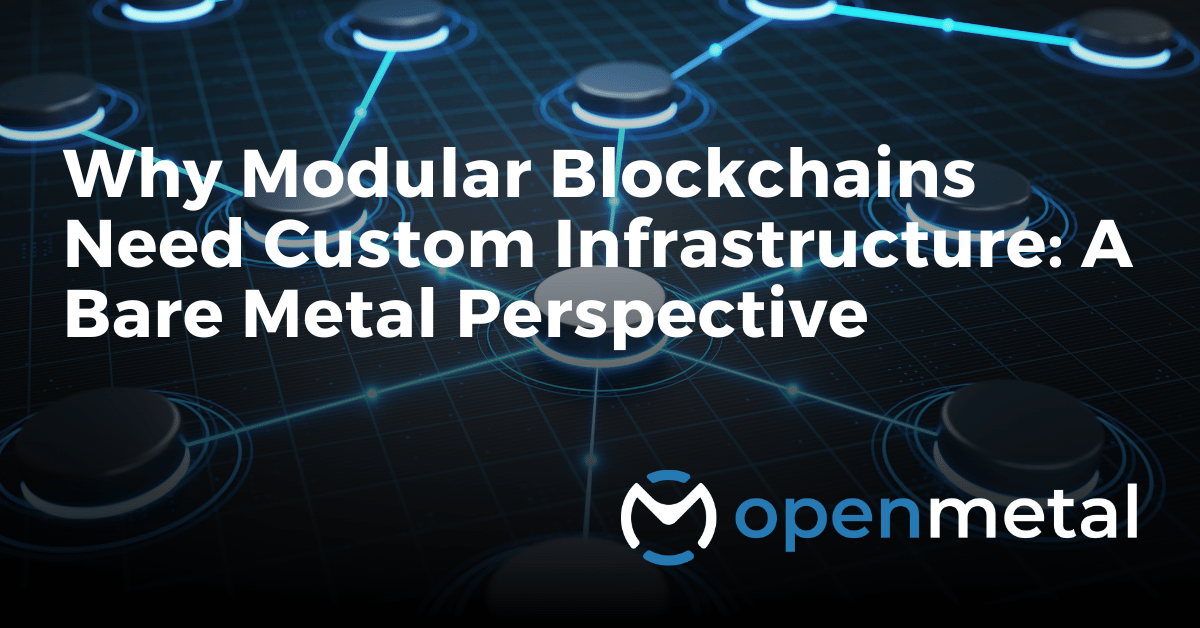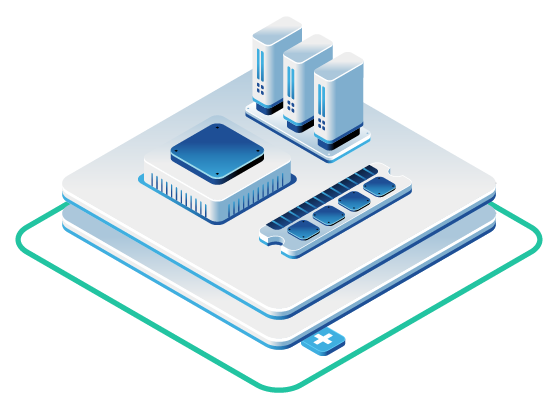
Modular blockchain design is reshaping how networks are built and scaled. If you’re building with frameworks like Celestia, Cosmos SDK, Avalanche Subnets, or Polygon CDK, your infrastructure needs don’t match traditional enterprise apps. You’re not just spinning up VMs—you’re coordinating validator nodes, DA layers, rollups, and sequencers.
To do that right, you need infrastructure that gives you more control and consistency than the big clouds can offer. Bare metal servers and hosted private clouds often provide the right combination of performance and predictability for modular blockchain systems.
What Is Modular Blockchain Infrastructure?
Unlike monolithic chains like Ethereum where execution, consensus, and data availability all happen on one layer, modular chains separate those responsibilities.
Here’s a breakdown of what “modular” looks like:
- Execution Layer: Handles smart contracts and application logic. Examples: rollups on Celestia or Polygon CDK.
- Consensus Layer: Manages agreement on the order of transactions. Often delegated to a proof-of-stake validator network.
- Data Availability Layer (DA Layer): Stores and confirms raw transaction data so rollups can validate it later. Example: Celestia’s core DA layer.
Because these layers operate independently and communicate across chains or rollups, network latency and consistency between nodes becomes a major infrastructure challenge.
Why Hyperscale Clouds Struggle to Support Modular Chains
Modular blockchains can struggle with general-purpose cloud infrastructure for a few reasons:
- Latency Sensitivity: Validator nodes and sequencers need to talk to each other quickly. If your cloud VMs are scattered across availability zones—or even continents—your network performance suffers.
- Inconsistent Performance: Cloud VMs share hardware with other tenants. That means performance can vary minute to minute, which is a problem for consensus algorithms and data availability services.
- Limited Hardware Control: With most public cloud providers, you can’t control CPU pinning, NUMA alignment, or network interface tuning—all of which matter for blockchain workloads.
- Networking Limits: High-throughput chains often hit bandwidth limits or face throttling in virtualized environments.
Even when tuned carefully, public cloud setups are often less consistent than bare metal alternatives.
Why Bare Metal Servers Fit Modular Blockchains
Bare metal hosting removes the abstraction. You get the physical server—no hypervisor, no noisy neighbors.
Here’s what that buys you when running a modular blockchain:
- Dedicated Resources: Full access to CPU, RAM, disk I/O, and networking means you avoid the variability of shared environments.
- Predictable Latency: Validator nodes and sequencers can run in physically close proximity with consistent network throughput.
- Hardware Customization: You can use NVMe for DA layers, GPU passthrough for zk-rollup proofs, or additional drives for long-term ledger storage.
- Security Isolation: No shared virtualization stack means fewer attack surfaces for your validator keys or rollup logic.
If you’re running validator nodes or data availability layers, this level of control matters.
For more detail, check out our post on How Blockchain Workloads on Bare Metal Go Beyond Cryptocurrency.
Use Cases: Where Bare Metal Really Matters
At OpenMetal, we’ve seen teams building modular infrastructure benefit most from bare metal when:
- Running Tendermint-Based Validator Nodes: Cosmos chains rely on low-latency consensus. Validator performance and uptime directly impact rewards.
- Hosting Rollups or Sequencers: Whether on Polygon CDK or Celestia, rollup layers require predictable compute and network behavior.
- Storing High-Volume DA Layers: Using Ceph storage to store and retrieve large amounts of transaction data across nodes.
- Supporting zk-SNARK or zk-STARK Proof Generation: These cryptographic workloads benefit from direct access to GPU acceleration and memory isolation.
We highlighted this in our use case blog: Running Blockchain Infrastructure for Crypto Trading and Validator Workloads.
Bare Metal vs. Hyperscale for Modular Chains
| Feature | Hyperscale Cloud | Bare Metal / Private Cloud |
| CPU Sharing | Yes | No |
| Latency Control | Limited | Full |
| Hardware Customization | No | Yes |
| Multi-tenancy | Yes | No |
| Bandwidth Consistency | Variable | Dedicated |
| Root Access | Limited | Full |
You may be able to tune a hyperscaler VM for decent performance, but for validator nodes and DA layers, “decent” might not cut it.
OpenMetal’s Infrastructure Advantage
OpenMetal offers Bare Metal Servers, Hosted Private Clouds, and Ceph Storage built specifically for infrastructure-heavy workloads like modular blockchains. Here’s what you get:
- Hardware Designed for Blockchain: Large V4 and XL V4 instances with dedicated drives, Intel CPUs, and NVMe storage.
- Private Cloud Option: Launch an OpenStack-based private cloud on bare metal in 45 seconds—fully isolated and under your control.
- Ceph Storage Clusters: Built for blockchain teams needing high-availability object and block storage to support DA and ledger replication.
If you’re building the next generation of blockchain infrastructure, let’s talk. We’ve supported everything from modular validator clusters to Web3 trading engines, and we’d be happy to help your team do the same.
Read More on the OpenMetal Blog


































